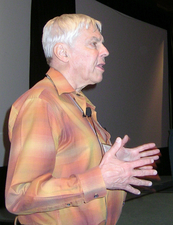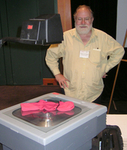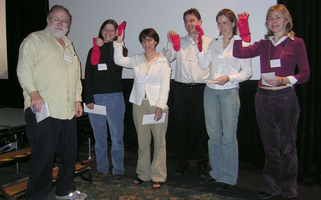| Handling editor: |
Hinke Osinga |
| Photographs: |
Bernd
Krauskopf |
| Written by:
|
Björn Sandstede (University of Surrey, UK)
and
Rachel Kuske (University of British Columbia,
Canada). |
The Snowbird 2005 conference, held from 22-26 May 2005
in (you guessed it) Snowbird/Utah, was the eighth of a series of
meetings organized by the SIAM Activity Group on Dynamical Systems. The
biannual Snowbird conference is arguably one of the broadest and most
important meetings for mathematicians, engineers and scientists
interested in nonlinear dynamics and its interdisciplinary
applications. In numbers: Snowbird 2005 drew 640 participants coming
from 28 countries. About 594 of the attendees came from academia, 27
from Government, 15 from industry and 4 indicated none of these
categories. The program consisted of 10 plenary presentations, 108
mini-symposia comprising 544 speakers, 55 contributed sessions with
152 talks, and a poster session with 46 posters. Fifteen mini-symposia
involved organizers from industry, non-profit organizations, and
various US and non-US government agencies or laboratories.
 |
|
The plenary talks represented a broad
cross-section of recent mathematical results in dynamical systems
theory, as well as engineering and scientific applications of
nonlinear dynamics: Topics covered in dynamical systems areas ranged
from theoretical results in ergodic theory, Hamiltonian maps and
dispersive PDEs to new phenomena in pattern-forming systems. Other
talks addressed interdisciplinary projects in turbulence, molecular
dynamics and robotic locomotion, and real-life problems applications
to electric power blackouts and call-center management. The ten
speakers and their topics were: |
| Steve Smale delivers
the Jürgen Moser Lecture. |
- Rafael de la Llave, University of Texas, Austin
Invariant Manifolds: Theorems, Algorithms and Conjectures
- Ian Dobson, University of Wisconsin, Madison
Cascading Failureand Complex Dynamics in Large Blackouts
- Charles Doering, University of Michigan
Turbulent Transport, Dissipation and Drag
- William A. Massey, Princeton University
A Dynamical Systems Analysis for Stochastic Models of Call
Centers
- Yasumasa Nishiura, Hokkaido University, Japan
Dynamics of Particle Patterns in Dissipative Systems
- Andy Ruina, Cornell University
The Existence and Stability of Limit Cycles as a Means to
Understanding Animal- and Designing Robotic Locomotion
- Christof Schütte, Free University of Berlin, Germany
Metastability in Complex Systems
- Gigliola Staffilani, Massachusetts Institute of Technology
Recent Results on Local and Global Well-Posedness for some
Dispersive Equations
- Shankar Venkataramani, University of Arizona
Non-convex Variational Problems: Multiple-scale Behaviors in
Equilibrium
- Amie Wilkinson, Northwestern University
Stable Ergodicity: A Little Hyperbolicity is Often Enough
For some of the plenary speakers this was the first Snowbird
conference that they had attended. This fact, together with their
confirmation of enjoying DS05, is further evidence of the increasing
breadth that the conference represents.
 |
|
The diversity of the broad research
interests of the Snowbird community were very visible in the topics
represented in the mini-symposia and contributed sessions. The
overwhelming part of mini-symposium and contributed talks focused on
how dynamical systems can be used in interdisciplinary research and
how, conversely, applications generate new mathematical ideas and
techniques. Overall, we felt that there was a good balance between
sessions in more `traditional' application areas such as fluid
dynamics and nonlinear optics, and newer emerging topics such as the
equation-free coarse-grained simulation of multiscale problems and
topological methods to classify patterns in
Rayleigh-Bénard |
|
 |
| Björn Sandstede at
the Snowbird meeting. |
Rachel Kuske at the Snowbird
meeting. |
convection and other systems. Theoretical core areas were represented
with topics ranging from normal forms, Lyapunov exponents, nontwist
Hamiltonian systems to hyperbolic dynamics. The contributed sessions
were of very high quality and very well attended. Among the specific
applications in industrial mathematics were the control and design of
satellites, modeling issues in the biotech industry, and the dynamics
of structures ranging from microwave devices to ships. Mathematical
biology was again strongly represented with many sessions on
neuroscience, synchrony, cardiac arrhythmias, angiogenesis, infectious
decease spreading, swarming and slime molds, to name but a few. This
year the number of mini-symposia covering stochastic processes saw a
sharp increase, with applications in oceanography, biology, networks,
and even one session discussing probabilistic models in sports.
One popular option for the mini-symposium format continues to be
the opportunity for two-part mini-symposium sessions. This year there
were 19 such double-headers, allowing an increased focus on a range of
topics in industrial, computational, theoretical, and applied
areas. Even more multi-part sessions were proposed, but due to space
and time constraints some of these were combined into a single session
(see the end of this article). Several sessions
included a new option available this year: closing a longer
mini-symposium session with a panel discussion on the session topic,
with the speakers as the panel.
 |
| John Guckenheimer hands
Dwight Barkley the JD Crawford Prize. |
At a ceremony on the first evening of the conference, the SIAM
Activity Group awarded the
Jürgen Moser Lecture Prize and the
JD Crawford Prize.
The 2005 Jürgen Moser Lecture Prize was awarded to
Stephen
Smale (Toyota Technological Institute at Chicago) who spoke about
Dynamics and Learning. The recipient of the 2005 JD Crawford Prize is
Dwight Barkley (University of Warwick).
 |
|
The evening poster session, with dessert
and coffee, has continued to be a very well attended, successful
event. Jim Yorke, together with Robert Ghrist, Mark Levi, Paul
Milewski, Wim van Saarloos and William Troy, who served as judges,
awarded four "Red Sock Awards" for the most outstanding posters. The
recipients of a (new) pair of red socks and a cash prize of $100
each were
- Margaret Beck (Boston University)
- Maria Leite (University of Houston)
- Maria Carmen Romano and Marco Thiel (University of Potsdam)
- Yulia Timofeeva (Heriot-Watt University)
|
| Jim Yorke with one
of the Red Sock Awards. |
 |
| Jim York with the
winners of the poster session, from left to right: Margaret Beck,
Maria Leite, Marco Thiel, Maria Carmen Romano, and Yulia
Timofeeva. |
This year, DSWeb ran for the first time a graduate
student competition for tutorials on dynamical systems; see also the
featured Tutorials article.
Evelyn Sander, the Section-Chief-Editor of
DSWeb Tutorials, announced the winners of this
contest:
- Sam Reid (University of Colorado at Boulder)
- David M. Winterbottom (University of Nottingham)
- Shawn C. Shadden (California Institute of Technology)
Brian Bockelman (University of Nebraska at Lincoln) was runner-up, and
Sebastian M. Marotta (Boston University) and Gouhei Tanaka (University
of Tokyo) received honorable mentions. |
|
 |
| Winners of the
DSWeb Tutorials competition. |
So far for the good news. The flipside of the
success of the Snowbird meetings is their continued growth,
seemingly without bounds: We received 128 mini-symposium
submissions for Snowbird 2005, an increase by roughly 15% from the
numbers for 2003, with space and time allotted in the program for only
110. This increase occurred despite announcing, and enforcing, for the
first time a limit of two mini-symposium talks per speaker. Thus, we
had, again for the first time, to reduce the number of sessions for
reasons of space rather than quality or appropriateness of the
proposed topic. This year we were able to minimize the number of
rejections by combining some sessions and replacing some mini-symposia
proposed as two shorter sessions with one longer session.
Various suggestions were made during the SIAG business meeting to
address this issue. One possibility is to enforce an existing SIAM
rule that limits speakers to one mini-symposium talk (not counting
speakers who filled in for colleagues who cancelled their talks, there
were 50 speakers with two mini-symposium talks). Another possibility
is to allow potential mini-symposium organizers to post title and
abstract of their proposed session on a central website, thus making
it possible to coordinate and combine sessions with overlapping topics
before submitting speaker names to SIAM.
We would like to thank SIAM's conference staff who organized and
managed all logistical aspects of this meeting in an extremely
efficient and professional fashion. We are also grateful to the other
members of the Organizing Committee, namely Nick Ercolani, Robert
Ghrist, John Guckenheimer, Mark Levi, and Emily Stone, for their
tremendous help and support in putting this meeting together.
In the hope of seeing many of you at Snowbird 2007,
Rachel Kuske and Björn Sandstede
Co-Chairs, DS05.